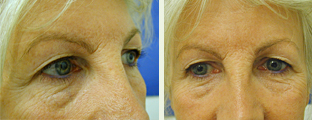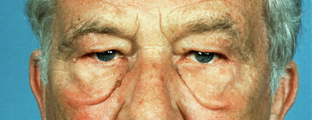AESTHETIC SURGERY
Eyelid Surgery
With advancing age and in some cases natural predisposition, the skin around the eyes becomes flaccid and the muscles lose some of their tone. This leads to an excess of skin and droopy lids, giving a tired, haggard, or worn-out impression. In extreme cases, the lids may even feel heavy or limit the patient’s field of vision when looking up.
The patient may be bothered by this, or friends and relatives may frequently inquire about his or her mood or state of health.

“Hooded eyes” with significant excess skin

“Bags under the eyes”
 What happens during the examination and diagnostic assessment?
What happens during the examination and diagnostic assessment?Thorough diagnostic assessment and consideration of the patient’s medical history are prerequisites for successful treatment. The examination consists of evaluation of the excess skin, the extent of the drooping, and the elasticity of the lid structures. It is advisable to have an optician measure the intraocular pressure, and careful photo documentation is of course necessary.
 What are the surgical techniques used?
What are the surgical techniques used?The incision is usually made externally, either along the main fold in the upper lid or in the shadows of the lashes for lower lid operations, and the resulting scar is thus completely unnoticeable.
For some patients, it may be possible to make the incision through the conjunctiva of the lower lid, resulting in no visible scarring at all.

Surgery for hooded eyes and bags under the eyes.
 What is the operation like?
What is the operation like?Lasting about 60 minutes, the procedure is painlessly conducted on an outpatient basis under local anesthesia with procedural sedation. On the patient’s request, the procedure can also be conducted under general anesthesia. Exact guidelines for the incisions are drawn on the face with the patient in a seated position so that the influence of gravity on the skin to be removed may be taken into account. The operation is conducted immediately afterwards with the patient lying horizontally. Depending on the patient, some of the muscle tissue and subcutaneous fat may also be removed.
 What happens after the operation?
What happens after the operation?After the operation, the patient can expect moderate pain at the incision sites to last for a few hours, although pain-relief medication is generally not necessary. Ice packs should be applied to the eye area, and physically strenuous tasks should be avoided for four weeks. Swelling is to be expected, but it should subside within a few days. Patients who tend to bruise easily may experience a blue discoloration of the skin. The sutures are removed 5 days after the operation.
 Could there be any complications?
Could there be any complications?Only rarely are eyelid surgeries complicated by postoperative hemorrhaging or infection, in which case immediate treatment is required. In order to achieve perfect results and a symmetrical appearance, it may be necessary to perform a minor, secondary procedure, e.g. a small excision of skin, six months after the initial surgery.
Berlin 2010, Dr. med. Dr. med. dent. Herbert Kindermann